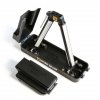Welcome and good for you wanting to learn to sharpen!!!
#1 - Angle is king
#2 - A marker (I prefer red) is an awesome tool to help achieving #1. Mark the edge bevel and it will
show you what is happening. Be aware, factory edge are notoriously uneven so you might be getting a good bit of the edge but not all of it. That's just the way it goes and there's pretty much always some amount of re-profiling that you do. If for no other reason, than just working the bevel to your chosen media and style.
Unlike a lot of folks, I'm absolutely not a fan of fixed V "systems" like the Sharpmaker. Sal designed the Sharpmaker for his knives so the angles are set to what he chose to grind his edges to. You have very little flexibility and therefore all your knives must conform to one of the two available options.
The types of steels you want to sharpen will play some role in the stone types you want but there is no hard rule here and there are nuances.
I used a KME system for many years and it is a great system. There is nothing at all wrong with using one of the many systems out there (although I'd avoid cheap ones with only a couple angle choices).
That said, I would really encourage learning how to freehand. It opens up so many possibilities in terms of stone choices, tailored and preferred edges, simplicity. I strongly recommend sticking with 8" stones. 6" stones can be attractive due to price but they can be really limited. An 8" will work for small pocket knives to most home kitchen knives.
You would be hard pressed to beat a Norton Cystolon combination (JB8) or Norton Crystolon course and a Fine India as starting stones. I would recommend a universal stone holder to go with it. Techincally, the Norton's storage case can serve as a stone holder so you can even skiip that if you really want but the dedicated holder is very nice. You do not want polished edges for the work you're describing and a silicon carbide stone like the Crystolon can handle most all steel types. Folks will tell you that you can sharpen high vanadium steels like S30V, S90V, etc. on SiC but that's not accurate. You can and they will sharpen those steels. Now, past around 600 grit or so, things can change with those steels and tear out and such starts becoming an issue but for what you want, I wouldn't go that high anyway.
You can strop on paint stick from the hardware store.
@ToddS has a great website called the Science of Sharp. Very good info for beginner to advanced sharpeners.
It really comes down to this:
Step One: Achieve First Burr. Work one edge of the knife until you form a burr. The burr will be on the opposite side you're working. In the case of bench stones, the burr will form on the side of the knife that is facing you. You'll be able to feel it. The worked side will be smooth and the other side will have a little "catch". Feel each side before you start for reference. The marker will help you see if you're getting the full bevel and all the way to the edge. If the marker is only coming off the very edge, you're too high. If it is just coming off the shoulder, too low. Get a burr along the entire edge. You have to lift a little for the belly and tip.
Step Two: Achieve Second Burr. Do the exact same thing on the other side of the knife.
Step Three: De-burr. Once you've raised that second burr, then you do very light strokes on the stone flipping sides with each stroke. Some will do this as edge leading (the edge is moving into the stone in the direction of your stroke) and some will do it as edge trialing (the spine is moving in the direction of your stroke). This might take a couple passes or maybe more but you don't want any burr left on the edge. A 10x or 20x loupe can help you see things. This basically stropping on the stone.
Then you can do some very light stropping on an old belt, piece of denim, cardboard, wood, whatever. For lower alloy steels you can probably get away with no compound, but even a little wheel polish or rouge from the hardware store will work.
Now, there is a ton to learn in sharpening and people will have their own preferences an such, but those three steps are the fundamentals. Sharpening is very rewarding and you can do it!

